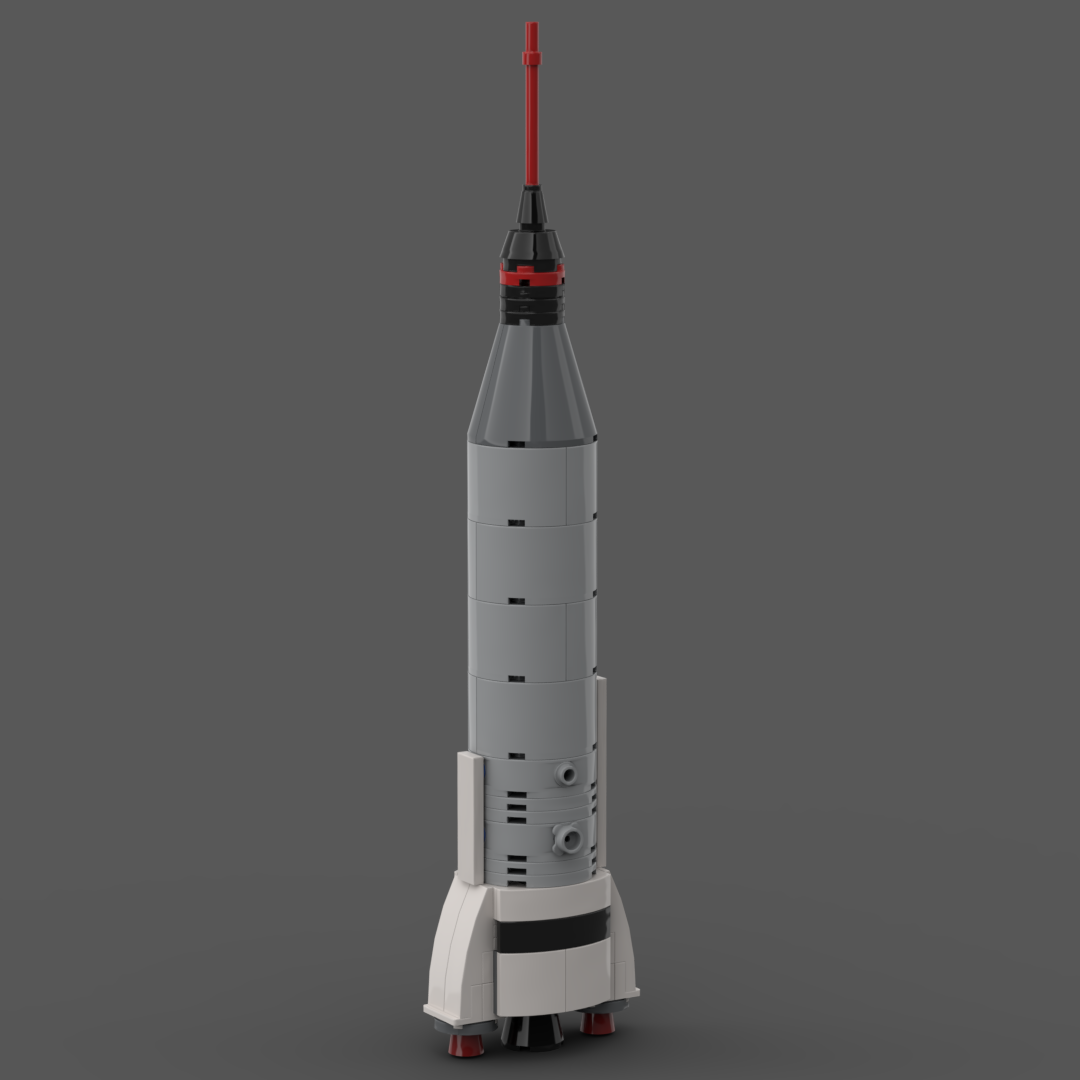
LEGO Designer:
Grant Passmore (Eiffelman)
Designed:
June 2017
Categories:
Manned Spaceflight, All, Launch Vehicles, Small Lift Launch Vehicles, Space Agency - NASA
Further Information and References:
Wikipedia
Astronautix
NASA : This New Ocean - A History of Project mercury
Launch Vehicle Details
Stages:
1 stage + strap-on boosters
Length:
24 m
Diameter:
3.05 m
Mass at Launch:
119 tonnes
Low Earth Orbit Capacity:
1400 kg
Total Thrust:
1629 kN
Apogee:
1855 km
Class:
Small Lift Launch Vehicle
Mercury-Atlas was a subprogram of Project Mercury that included most of the flights and tests using the Atlas LV-3B launch vehicle. The Atlas was also used for one Mercury flight under the Big Joe subprogram.
The Mercury mission numbering system was: a two-letter designation marking the launch vehicle type, followed by a dash, then a number designating the flight/test number. The Atlas launch vehicles used for Project Mercury were given a two- or three-digit number followed by a “-D”, indicating that they were the “D” version of the Atlas.
Manned flights:
- Mercury-Atlas 6 (MA-6)
was the first American orbital spaceflight, which took place on February 20, 1962. Piloted by astronaut John Glenn and operated by NASA as part of Project Mercury, it was the fifth human spaceflight, preceded by Soviet orbital flights Vostok 1 and 2 and American sub-orbital flights Mercury-Redstone 3 and 4. - Mercury-Atlas 7 (MA-7)
launched May 24, 1962, was the fourth crewed flight of Project Mercury. The spacecraft, named Aurora 7, was piloted by astronaut Scott Carpenter. He was the sixth human to fly in space. The mission used Mercury spacecraft No. 18 and Atlas launch vehicle No. 107-D. - Mercury-Atlas 8 (MA-8)
was the fifth United States crewed space mission, part of NASA’s Mercury program. Astronaut Walter M. Schirra Jr., orbited the Earth six times in the Sigma 7 spacecraft on October 3, 1962, in a nine-hour flight focused mainly on technical evaluation rather than on scientific experimentation. This was the longest U.S. crewed orbital flight yet achieved in the Space Race, though well behind the several-day record set by the Soviet Vostok 3 earlier in the year. It confirmed the Mercury spacecraft’s durability ahead of the one-day Mercury-Atlas 9 mission that followed in 1963. - Mercury-Atlas 9 (MA-9)
was the final crewed space mission of the U.S. Mercury program, launched on May 15, 1963 from Launch Complex 14 at Cape Canaveral, Florida. The spacecraft, named Faith 7, completed 22 Earth orbits before splashing down in the Pacific Ocean, piloted by astronaut Gordon Cooper, then a United States Air Force major. The Atlas rocket was No. 130-D, and the Mercury spacecraft was No. 20. This mission marks the last time an American was launched alone to conduct an entirely solo orbital mission.
Downloads
Part count: 80 bricks, 34 lots.
| Unit | width | length | height |
|---|---|---|---|
| Studs | 6.8 | 4.8 | 31.8 |
| Inches | 2.1 | 1.5 | 10 |
| Centimetres | 5.4 | 3.8 | 25.4 |
Nr TNr Vehicle Serial Date LS Payload
30 1 Atlas-D Mercury 10D 09.09.1959 P CC LC-14 * Mercury BJ-1
58 2 Atlas-D Mercury 50D 29.07.1960 F CC LC-14 * Mercury MA-1
78 3 Atlas-D Mercury 67D 21.02.1961 CC LC-14 * Mercury MA-2
82 4 Atlas-D Mercury 100D 25.04.1961 F CC LC-14 Mercury MA-3
96 5 Atlas-D Mercury 88D 13.09.1961 CC LC-14 Mercury MA-4
104 6 Atlas-D Mercury 93D 29.11.1961 CC LC-14 Mercury MA-5
117 7 Atlas-D Mercury 109D 20.02.1962 CC LC-14 Mercury MA-6
130 8 Atlas-D Mercury 107D 24.05.1962 CC LC-14 Mercury MA-7 / Balloon Subsat 1
147 9 Atlas-D Mercury 113D 03.10.1962 CC LC-14 Mercury MA-8
174 10 Atlas-D Mercury 130D 15.05.1963 CC LC-14 Mercury MA-9 / Balloon Subsat 2 / Flashing Light Subsat
Failures:
Flight 2: Booster section failed to separate from sustainer
Launch sites:
CC = Cape Canaveral Air Force Station, Eastern Test Range, Cape Canaveral, Florida, USA
F Failure
* Suborbital
Launch History information from space.skyrocket.de
Launch History information from space.skyrocket.de
Related Posts
None found

